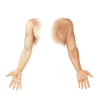S2) Dermatomes, Myotomes and Segmental Innervation of the Limbs Flashcards
What is a dermatome?
A dermatome is the area of skin supplied by a single spinal nerve e.g. C5 supplies the skin on the lateral aspect of the arm

How are dermatomes named?
Each dermatome is named according to the spinal nerve which provides most of its sensory innervation

Why don’t spinal cord lesions/damage ever result in the loss of sensation in an entire dermatome?
There is considerable overlap between adjacent dermatomes so transection of a single dorsal spinal nerve root doesn’t usually lead to anaesthesia of the entire dermatome

Describe the embryonic development of dermatomes
- Nerves grow into the developing limb buds
- As the limb buds increase in size, the nerves are ‘dragged’ along with the structures they innervate thus eventually producing the adult pattern

Describe the anatomical distribution of the dermatomes in the upper limb

The upper limb is innervated by the anterior primary rami of spinal nerves originating from C5 to T1

Describe the anatomical distribution of the dermatomes in the lower limb

The lower limb is innervated by the anterior primary rami of spinal nerves originating from L2-5 and S1-3

What is a myotome?
A myotome is the group of muscles innervated by a single nerve root (motor equivalent of a dermatome) e.g. C5 myotome includes the flexors of the elbow and the abductors of the shoulder

In embryology, what does the term myotome refer to?
Myotome is also used in embryology to describe that part of the somite which develops into the muscles

State the segmental innervation of all movements in the upper limb

- C5: shoulder abduction and lateral rotation
- C6: elbow flexion, wrist extension, supination, medial rotation
- C7: elbow extension, wrist flexion, pronation
- C8: finger flexion, finger extension
- T1: finger abduction and adduction

State the segmental innervation of all movements in the lower limb

- L2: hip flexion
- L3: knee extension, hip adduction
- L4: ankle dorsiflexion
- L5: great toe extension, ankle inversion, hip abduction
- S1: ankle plantarflexion, ankle eversion, hip extension
- S2: knee flexion, great toe flexion
- S3-S4: anal wink

Describe the formation of a peripheral nerve
Nerve fibres leave the spinal cord to supply the limb and travel through the spinal nerve root and are redistributed via the nerve plexuses to become peripheral nerves

What is the cutaneous distribution of a peripheral nerve?
The cutaneous distribution of a peripheral nerve is the area of skin the peripheral nerve innervates and often contains nerve fibres from several spinal nerve roots

E.g. the radial nerve (C5-8,T1) innervates the skin of the anatomical snuff box
State the segmental sensory innervation of the skin of the upper limb


State the segmental sensory innervation of the skin of the lower limb


Describe the motor and sensory deficits caused by spinal nerve lesions
A lesion of a spinal nerve root (near the spinal cord) will cause loss of sensation in the relevant dermatome and also loss of function in the relevant myotome


